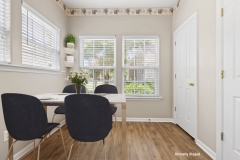
1489 Coolspring Way, Virginia Beach, VA | 3 Bedroom, 2½ Bath | Offered at $280,000
MLS Listing 10388252 – click here
Move-in Ready, meticulously maintained 2-story condo in The Commons, a community located in the Kempsville area of Virginia Beach. The Commons is a lovely, gated community with pool, clubhouse, and pond. The condo for sale is located in a very quiet section of the neighborhood; you can hear the sound of the water feature from the pond… so relaxing. Large Primary Bedroom on the first floor with large bath and walk-in closet. This home also has a beautiful eat-in-kitchen with new appliances and a separate dining area.
- Primary Bedroom on First floor
- Primary Bedroom has huge walk-in closet
- 2 Pantries
- All appliances convey
- 1-car garage with ample storage
- Beautiful clubhouse with pool.
- Community pond providing tranquil setting.
















































